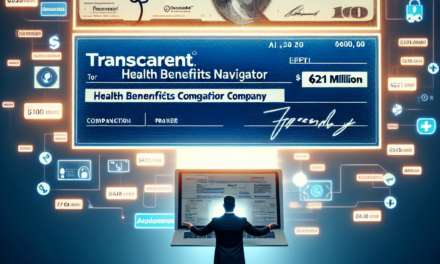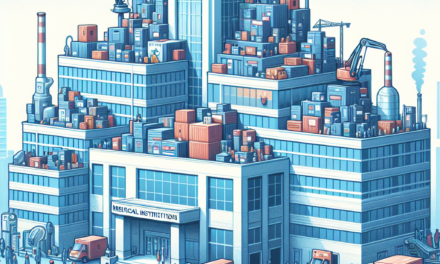Healthcare and Medtech Industries Prepare for Tariff Impacts
The healthcare and medtech industries are at a critical juncture as they navigate the complexities of global trade and tariffs. With the ongoing shifts in international trade policies, these sectors must adapt to potential tariff impacts that could affect everything from supply chains to pricing strategies. This article delves into the various ways the healthcare and medtech industries are preparing for these challenges, exploring the implications of tariffs, strategies for mitigation, and the broader economic context.
Understanding Tariffs and Their Implications
Tariffs are taxes imposed by governments on imported goods, designed to protect domestic industries from foreign competition. In the context of healthcare and medtech, tariffs can significantly impact the cost of medical devices, pharmaceuticals, and other essential products. Understanding the implications of these tariffs is crucial for stakeholders in the industry.
- Cost Increases: Tariffs can lead to increased costs for manufacturers who rely on imported components. For instance, a 25% tariff on certain medical devices can raise production costs, which may be passed on to consumers.
- Supply Chain Disruptions: Many healthcare companies depend on global supply chains. Tariffs can disrupt these networks, leading to delays and shortages of critical medical supplies.
- Market Access Challenges: Tariffs can limit market access for foreign companies, affecting competition and innovation within the healthcare sector.
- Investment Decisions: Uncertainty surrounding tariffs can influence investment decisions, with companies potentially delaying or scaling back expansion plans.
- Regulatory Compliance: Navigating the regulatory landscape becomes more complex with tariffs, as companies must ensure compliance with both domestic and international trade laws.
For example, the U.S.-China trade war has led to significant tariff increases on medical devices and pharmaceuticals, prompting companies to reassess their sourcing strategies. According to a report by the American Medical Device and Diagnostics Industry Association (AdvaMed), nearly 40% of medical devices sold in the U.S. are imported, making the industry particularly vulnerable to tariff fluctuations.
Strategies for Mitigating Tariff Impacts
As the healthcare and medtech industries face the reality of tariffs, companies are implementing various strategies to mitigate their impacts. These strategies range from supply chain diversification to price adjustments and lobbying efforts.
- Diversifying Supply Chains: Companies are increasingly looking to diversify their supply chains to reduce reliance on any single country. This may involve sourcing components from multiple countries or investing in domestic manufacturing capabilities.
- Price Adjustments: Some companies may choose to absorb tariff costs temporarily, while others may pass these costs onto consumers. This decision often depends on market conditions and competitive pressures.
- Lobbying for Policy Changes: Industry associations are actively lobbying for tariff exemptions or reductions, arguing that high tariffs can hinder innovation and access to essential medical technologies.
- Investing in Technology: Companies are investing in technology to improve efficiency and reduce costs. Automation and advanced manufacturing techniques can help offset some of the financial burdens imposed by tariffs.
- Strategic Partnerships: Forming strategic partnerships with local manufacturers can help companies navigate tariff challenges while enhancing their market presence.
For instance, Medtronic, a leading medical technology company, has taken steps to diversify its supply chain by investing in manufacturing facilities in countries less affected by tariffs. This proactive approach not only mitigates tariff impacts but also positions the company for long-term growth in emerging markets.
The Role of Innovation in Adapting to Tariff Changes
Innovation plays a crucial role in how the healthcare and medtech industries adapt to tariff changes. Companies that prioritize research and development (R&D) can create new products and solutions that not only comply with regulatory requirements but also meet the evolving needs of patients and healthcare providers.
- Developing Cost-Effective Solutions: Companies are focusing on developing cost-effective medical devices that can withstand tariff pressures. This includes designing products that use fewer imported components or are easier to manufacture domestically.
- Leveraging Digital Health Technologies: The rise of digital health technologies, such as telemedicine and remote monitoring, offers opportunities for companies to innovate while reducing reliance on traditional supply chains.
- Enhancing Product Portfolios: Companies are expanding their product portfolios to include a wider range of offerings, which can help mitigate the impact of tariffs on specific products.
- Collaborating with Startups: Established companies are increasingly collaborating with startups to leverage innovative technologies and solutions that can help them navigate tariff challenges.
- Investing in Sustainable Practices: Sustainability is becoming a key focus for many companies. By investing in sustainable practices, companies can not only reduce costs but also appeal to environmentally conscious consumers.
A notable example is Philips, which has invested heavily in R&D to develop innovative healthcare solutions that are both cost-effective and compliant with regulatory standards. By focusing on innovation, Philips has been able to maintain its competitive edge despite the challenges posed by tariffs.
Global Trade Dynamics and Their Impact on Healthcare
The global trade landscape is constantly evolving, and changes in trade policies can have far-reaching implications for the healthcare and medtech industries. Understanding these dynamics is essential for companies looking to navigate the complexities of international trade.
- Trade Agreements: Trade agreements can significantly impact tariffs and market access. For example, the United States-Mexico-Canada Agreement (USMCA) has provisions that affect the healthcare sector, including intellectual property protections and regulatory cooperation.
- Geopolitical Tensions: Geopolitical tensions can lead to sudden changes in trade policies, creating uncertainty for companies operating in multiple markets. The ongoing tensions between the U.S. and China are a prime example of how geopolitical factors can influence trade.
- Emerging Markets: As emerging markets continue to grow, companies are increasingly looking to these regions for expansion opportunities. However, navigating tariffs and trade regulations in these markets can be challenging.
- Global Supply Chain Resilience: The COVID-19 pandemic highlighted the vulnerabilities of global supply chains. Companies are now focusing on building more resilient supply chains that can withstand disruptions caused by tariffs or other factors.
- Regulatory Harmonization: Efforts to harmonize regulations across countries can facilitate trade and reduce the impact of tariffs. Companies that engage in advocacy for regulatory harmonization can benefit from smoother market access.
For instance, the European Union has been proactive in negotiating trade agreements that include provisions for healthcare products, helping to reduce tariffs and facilitate market access for European companies. Understanding these global trade dynamics is essential for companies looking to thrive in an increasingly interconnected world.
The Future of Healthcare and Medtech in a Tariff-Impacted World
As the healthcare and medtech industries continue to grapple with the impacts of tariffs, the future will likely be shaped by a combination of innovation, strategic planning, and adaptability. Companies that can effectively navigate these challenges will be better positioned for success in the long term.
- Increased Focus on Domestic Manufacturing: The trend toward reshoring and domestic manufacturing is likely to continue as companies seek to reduce their exposure to tariffs and supply chain disruptions.
- Emphasis on Collaboration: Collaboration between industry stakeholders, including manufacturers, healthcare providers, and policymakers, will be essential for addressing the challenges posed by tariffs.
- Investment in Technology: Continued investment in technology and innovation will be critical for companies looking to develop cost-effective solutions that can withstand tariff pressures.
- Adaptation to Regulatory Changes: Companies must remain agile and adaptable to changing regulatory environments, ensuring compliance while also advocating for favorable policies.
- Global Market Expansion: Despite the challenges posed by tariffs, companies will continue to seek opportunities for global market expansion, particularly in emerging markets with growing healthcare needs.
In conclusion, the healthcare and medtech industries are facing significant challenges as they prepare for the impacts of tariffs. By understanding the implications of tariffs, implementing effective mitigation strategies, prioritizing innovation, navigating global trade dynamics, and planning for the future, companies can position themselves for success in an increasingly complex landscape. The ability to adapt and respond to these challenges will ultimately determine the resilience and growth of the healthcare and medtech sectors in the years to come.





